Strategic Management of Singapore Airlines: A Comprehensive Report
VerifiedAdded on 2020/04/21
|23
|6166
|387
Report
AI Summary
This report provides a comprehensive analysis of the strategic management of Singapore Airlines (SIA). It begins with an executive summary, followed by an introduction to the company and its branding. The report delves into SIA's current financial situation, assessing past performance and financial strength, including revenue and profit figures. An external analysis examines market trends, opportunities, and threats, evaluating SIA's scope and competitive landscape. Internal analysis explores SIA's capabilities, particularly those that create value, and discusses its future scope. The report defines key problems facing SIA and proposes objectives. The Strategy Diamond model is applied to SIA, detailing staging and pacing, arenas, vehicles, economic logic, and differentiators. A chosen strategic alternative is selected, with justification for its superiority. Implementation considerations include changes in the corporate value chain, measures to track strategy implementation, and an examination of the environmental and social impact of strategic recommendations, including carbon footprint, environmental degradation, and labor conditions. The report concludes with references and appendices containing supporting financial data and analyses.
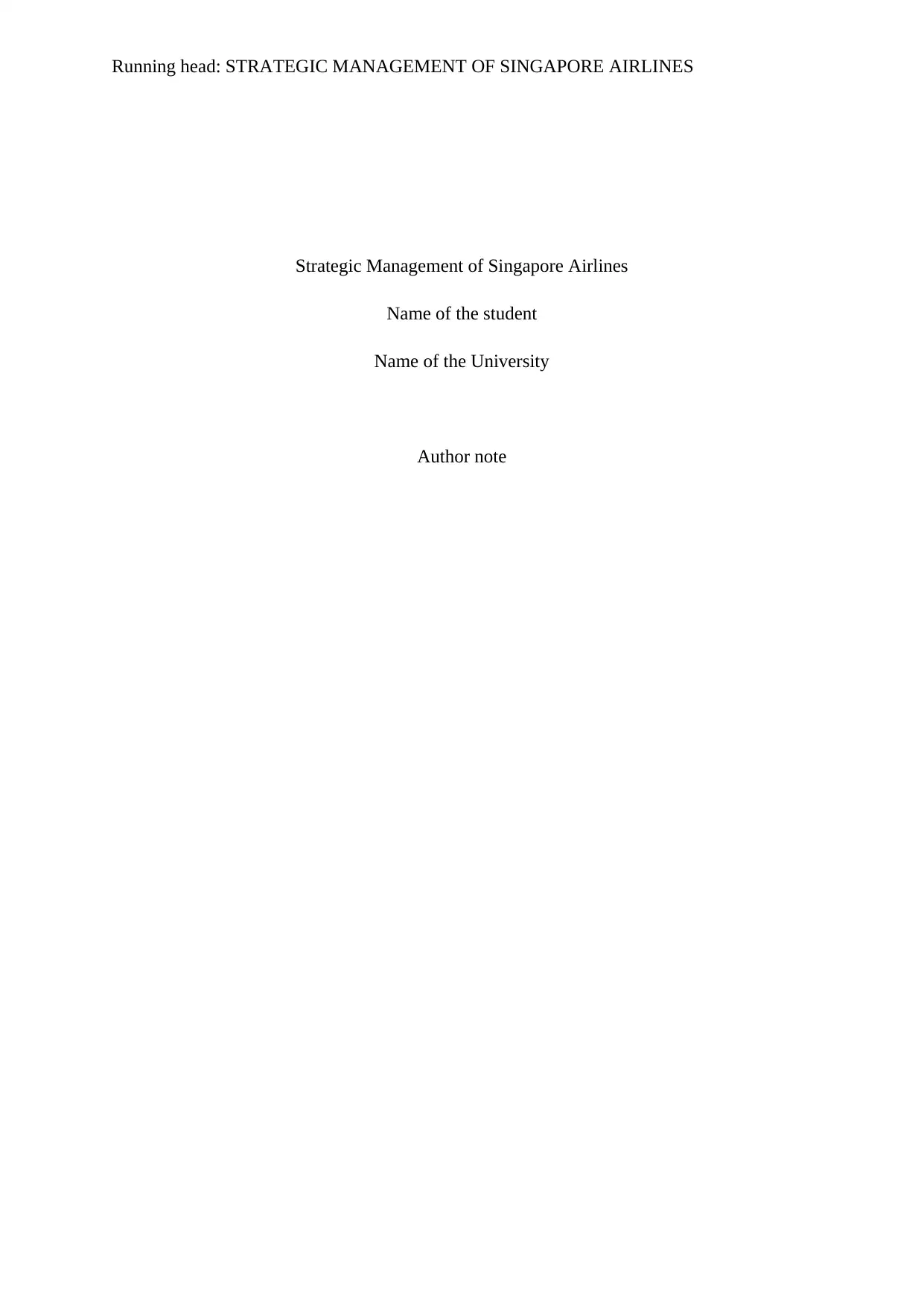
Running head: STRATEGIC MANAGEMENT OF SINGAPORE AIRLINES
Strategic Management of Singapore Airlines
Name of the student
Name of the University
Author note
Strategic Management of Singapore Airlines
Name of the student
Name of the University
Author note
Paraphrase This Document
Need a fresh take? Get an instant paraphrase of this document with our AI Paraphraser
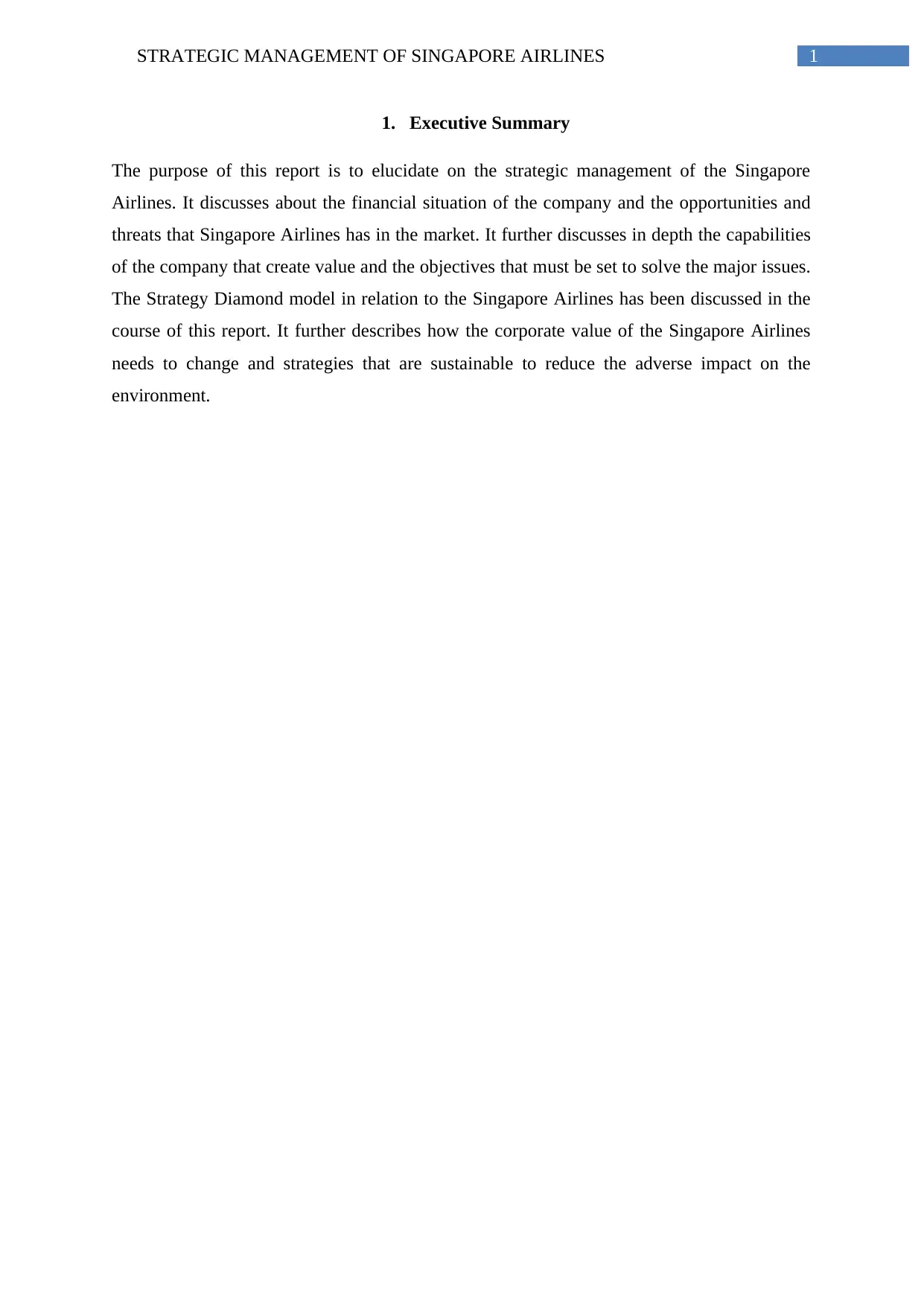
1STRATEGIC MANAGEMENT OF SINGAPORE AIRLINES
1. Executive Summary
The purpose of this report is to elucidate on the strategic management of the Singapore
Airlines. It discusses about the financial situation of the company and the opportunities and
threats that Singapore Airlines has in the market. It further discusses in depth the capabilities
of the company that create value and the objectives that must be set to solve the major issues.
The Strategy Diamond model in relation to the Singapore Airlines has been discussed in the
course of this report. It further describes how the corporate value of the Singapore Airlines
needs to change and strategies that are sustainable to reduce the adverse impact on the
environment.
1. Executive Summary
The purpose of this report is to elucidate on the strategic management of the Singapore
Airlines. It discusses about the financial situation of the company and the opportunities and
threats that Singapore Airlines has in the market. It further discusses in depth the capabilities
of the company that create value and the objectives that must be set to solve the major issues.
The Strategy Diamond model in relation to the Singapore Airlines has been discussed in the
course of this report. It further describes how the corporate value of the Singapore Airlines
needs to change and strategies that are sustainable to reduce the adverse impact on the
environment.
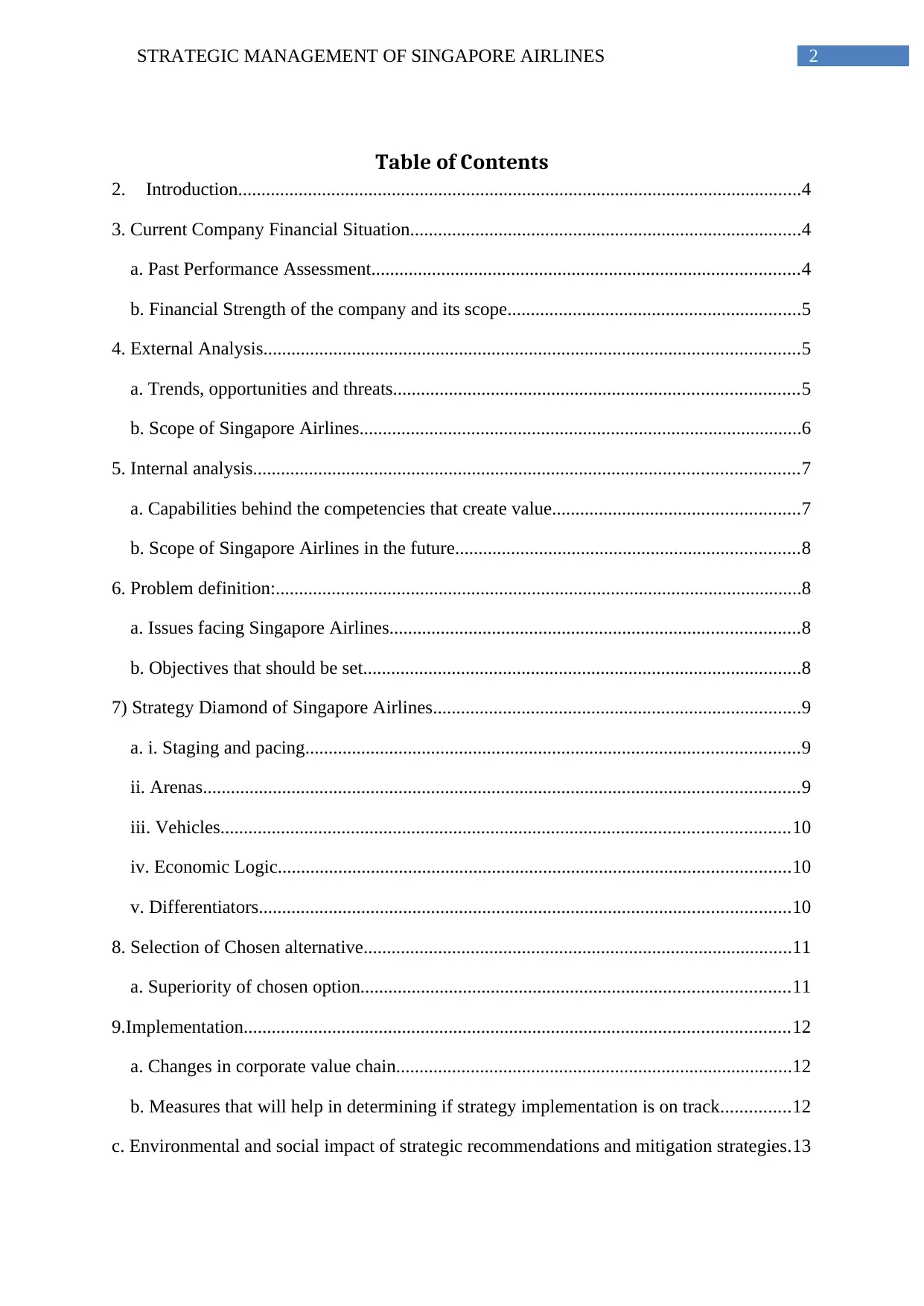
2STRATEGIC MANAGEMENT OF SINGAPORE AIRLINES
Table of Contents
2. Introduction.........................................................................................................................4
3. Current Company Financial Situation....................................................................................4
a. Past Performance Assessment............................................................................................4
b. Financial Strength of the company and its scope...............................................................5
4. External Analysis...................................................................................................................5
a. Trends, opportunities and threats.......................................................................................5
b. Scope of Singapore Airlines...............................................................................................6
5. Internal analysis.....................................................................................................................7
a. Capabilities behind the competencies that create value.....................................................7
b. Scope of Singapore Airlines in the future..........................................................................8
6. Problem definition:.................................................................................................................8
a. Issues facing Singapore Airlines........................................................................................8
b. Objectives that should be set..............................................................................................8
7) Strategy Diamond of Singapore Airlines...............................................................................9
a. i. Staging and pacing..........................................................................................................9
ii. Arenas................................................................................................................................9
iii. Vehicles..........................................................................................................................10
iv. Economic Logic..............................................................................................................10
v. Differentiators..................................................................................................................10
8. Selection of Chosen alternative............................................................................................11
a. Superiority of chosen option............................................................................................11
9.Implementation.....................................................................................................................12
a. Changes in corporate value chain.....................................................................................12
b. Measures that will help in determining if strategy implementation is on track...............12
c. Environmental and social impact of strategic recommendations and mitigation strategies.13
Table of Contents
2. Introduction.........................................................................................................................4
3. Current Company Financial Situation....................................................................................4
a. Past Performance Assessment............................................................................................4
b. Financial Strength of the company and its scope...............................................................5
4. External Analysis...................................................................................................................5
a. Trends, opportunities and threats.......................................................................................5
b. Scope of Singapore Airlines...............................................................................................6
5. Internal analysis.....................................................................................................................7
a. Capabilities behind the competencies that create value.....................................................7
b. Scope of Singapore Airlines in the future..........................................................................8
6. Problem definition:.................................................................................................................8
a. Issues facing Singapore Airlines........................................................................................8
b. Objectives that should be set..............................................................................................8
7) Strategy Diamond of Singapore Airlines...............................................................................9
a. i. Staging and pacing..........................................................................................................9
ii. Arenas................................................................................................................................9
iii. Vehicles..........................................................................................................................10
iv. Economic Logic..............................................................................................................10
v. Differentiators..................................................................................................................10
8. Selection of Chosen alternative............................................................................................11
a. Superiority of chosen option............................................................................................11
9.Implementation.....................................................................................................................12
a. Changes in corporate value chain.....................................................................................12
b. Measures that will help in determining if strategy implementation is on track...............12
c. Environmental and social impact of strategic recommendations and mitigation strategies.13
⊘ This is a preview!⊘
Do you want full access?
Subscribe today to unlock all pages.

Trusted by 1+ million students worldwide
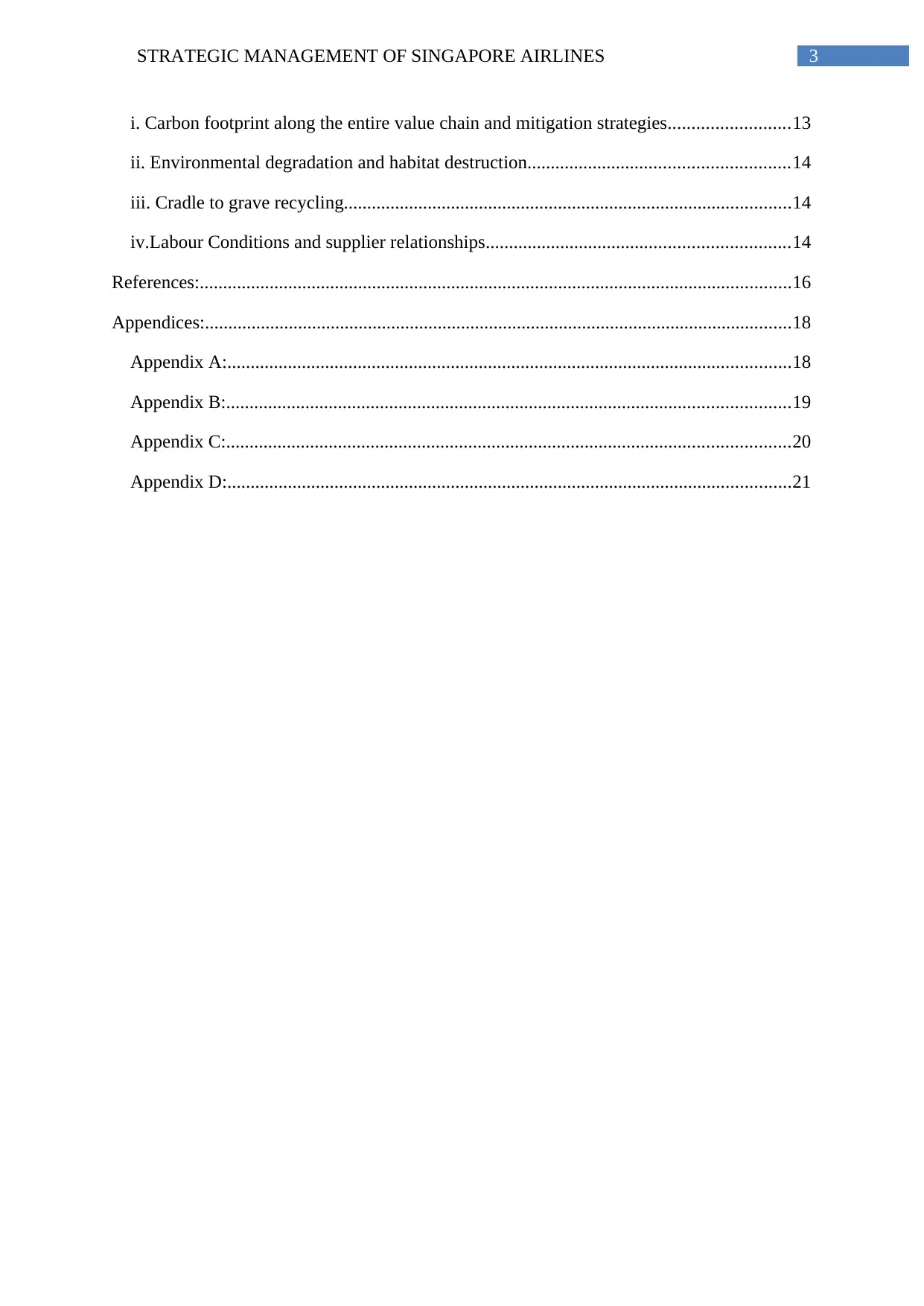
3STRATEGIC MANAGEMENT OF SINGAPORE AIRLINES
i. Carbon footprint along the entire value chain and mitigation strategies..........................13
ii. Environmental degradation and habitat destruction........................................................14
iii. Cradle to grave recycling................................................................................................14
iv.Labour Conditions and supplier relationships.................................................................14
References:...............................................................................................................................16
Appendices:..............................................................................................................................18
Appendix A:.........................................................................................................................18
Appendix B:.........................................................................................................................19
Appendix C:.........................................................................................................................20
Appendix D:.........................................................................................................................21
i. Carbon footprint along the entire value chain and mitigation strategies..........................13
ii. Environmental degradation and habitat destruction........................................................14
iii. Cradle to grave recycling................................................................................................14
iv.Labour Conditions and supplier relationships.................................................................14
References:...............................................................................................................................16
Appendices:..............................................................................................................................18
Appendix A:.........................................................................................................................18
Appendix B:.........................................................................................................................19
Appendix C:.........................................................................................................................20
Appendix D:.........................................................................................................................21
Paraphrase This Document
Need a fresh take? Get an instant paraphrase of this document with our AI Paraphraser
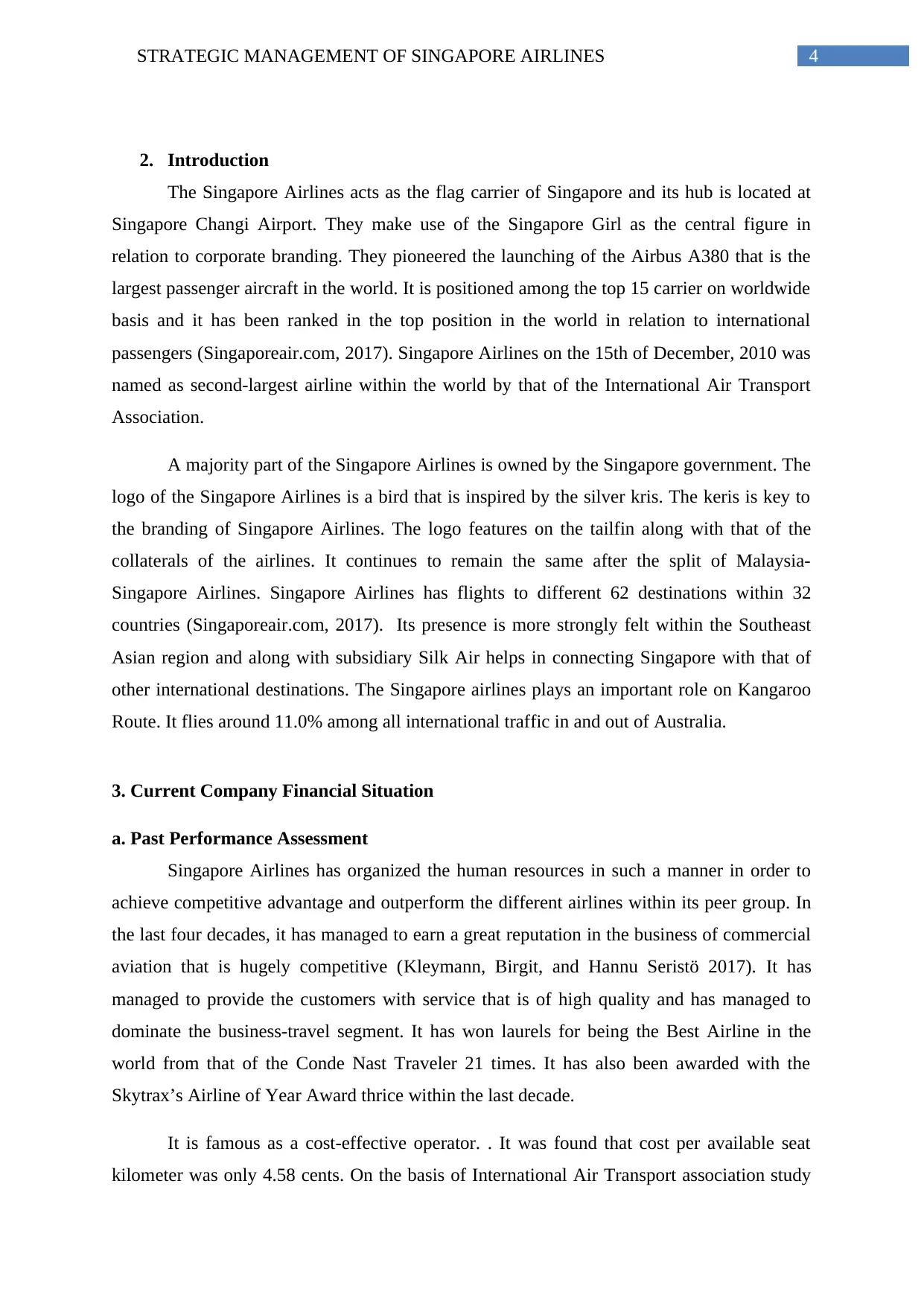
4STRATEGIC MANAGEMENT OF SINGAPORE AIRLINES
2. Introduction
The Singapore Airlines acts as the flag carrier of Singapore and its hub is located at
Singapore Changi Airport. They make use of the Singapore Girl as the central figure in
relation to corporate branding. They pioneered the launching of the Airbus A380 that is the
largest passenger aircraft in the world. It is positioned among the top 15 carrier on worldwide
basis and it has been ranked in the top position in the world in relation to international
passengers (Singaporeair.com, 2017). Singapore Airlines on the 15th of December, 2010 was
named as second-largest airline within the world by that of the International Air Transport
Association.
A majority part of the Singapore Airlines is owned by the Singapore government. The
logo of the Singapore Airlines is a bird that is inspired by the silver kris. The keris is key to
the branding of Singapore Airlines. The logo features on the tailfin along with that of the
collaterals of the airlines. It continues to remain the same after the split of Malaysia-
Singapore Airlines. Singapore Airlines has flights to different 62 destinations within 32
countries (Singaporeair.com, 2017). Its presence is more strongly felt within the Southeast
Asian region and along with subsidiary Silk Air helps in connecting Singapore with that of
other international destinations. The Singapore airlines plays an important role on Kangaroo
Route. It flies around 11.0% among all international traffic in and out of Australia.
3. Current Company Financial Situation
a. Past Performance Assessment
Singapore Airlines has organized the human resources in such a manner in order to
achieve competitive advantage and outperform the different airlines within its peer group. In
the last four decades, it has managed to earn a great reputation in the business of commercial
aviation that is hugely competitive (Kleymann, Birgit, and Hannu Seristö 2017). It has
managed to provide the customers with service that is of high quality and has managed to
dominate the business-travel segment. It has won laurels for being the Best Airline in the
world from that of the Conde Nast Traveler 21 times. It has also been awarded with the
Skytrax’s Airline of Year Award thrice within the last decade.
It is famous as a cost-effective operator. . It was found that cost per available seat
kilometer was only 4.58 cents. On the basis of International Air Transport association study
2. Introduction
The Singapore Airlines acts as the flag carrier of Singapore and its hub is located at
Singapore Changi Airport. They make use of the Singapore Girl as the central figure in
relation to corporate branding. They pioneered the launching of the Airbus A380 that is the
largest passenger aircraft in the world. It is positioned among the top 15 carrier on worldwide
basis and it has been ranked in the top position in the world in relation to international
passengers (Singaporeair.com, 2017). Singapore Airlines on the 15th of December, 2010 was
named as second-largest airline within the world by that of the International Air Transport
Association.
A majority part of the Singapore Airlines is owned by the Singapore government. The
logo of the Singapore Airlines is a bird that is inspired by the silver kris. The keris is key to
the branding of Singapore Airlines. The logo features on the tailfin along with that of the
collaterals of the airlines. It continues to remain the same after the split of Malaysia-
Singapore Airlines. Singapore Airlines has flights to different 62 destinations within 32
countries (Singaporeair.com, 2017). Its presence is more strongly felt within the Southeast
Asian region and along with subsidiary Silk Air helps in connecting Singapore with that of
other international destinations. The Singapore airlines plays an important role on Kangaroo
Route. It flies around 11.0% among all international traffic in and out of Australia.
3. Current Company Financial Situation
a. Past Performance Assessment
Singapore Airlines has organized the human resources in such a manner in order to
achieve competitive advantage and outperform the different airlines within its peer group. In
the last four decades, it has managed to earn a great reputation in the business of commercial
aviation that is hugely competitive (Kleymann, Birgit, and Hannu Seristö 2017). It has
managed to provide the customers with service that is of high quality and has managed to
dominate the business-travel segment. It has won laurels for being the Best Airline in the
world from that of the Conde Nast Traveler 21 times. It has also been awarded with the
Skytrax’s Airline of Year Award thrice within the last decade.
It is famous as a cost-effective operator. . It was found that cost per available seat
kilometer was only 4.58 cents. On the basis of International Air Transport association study
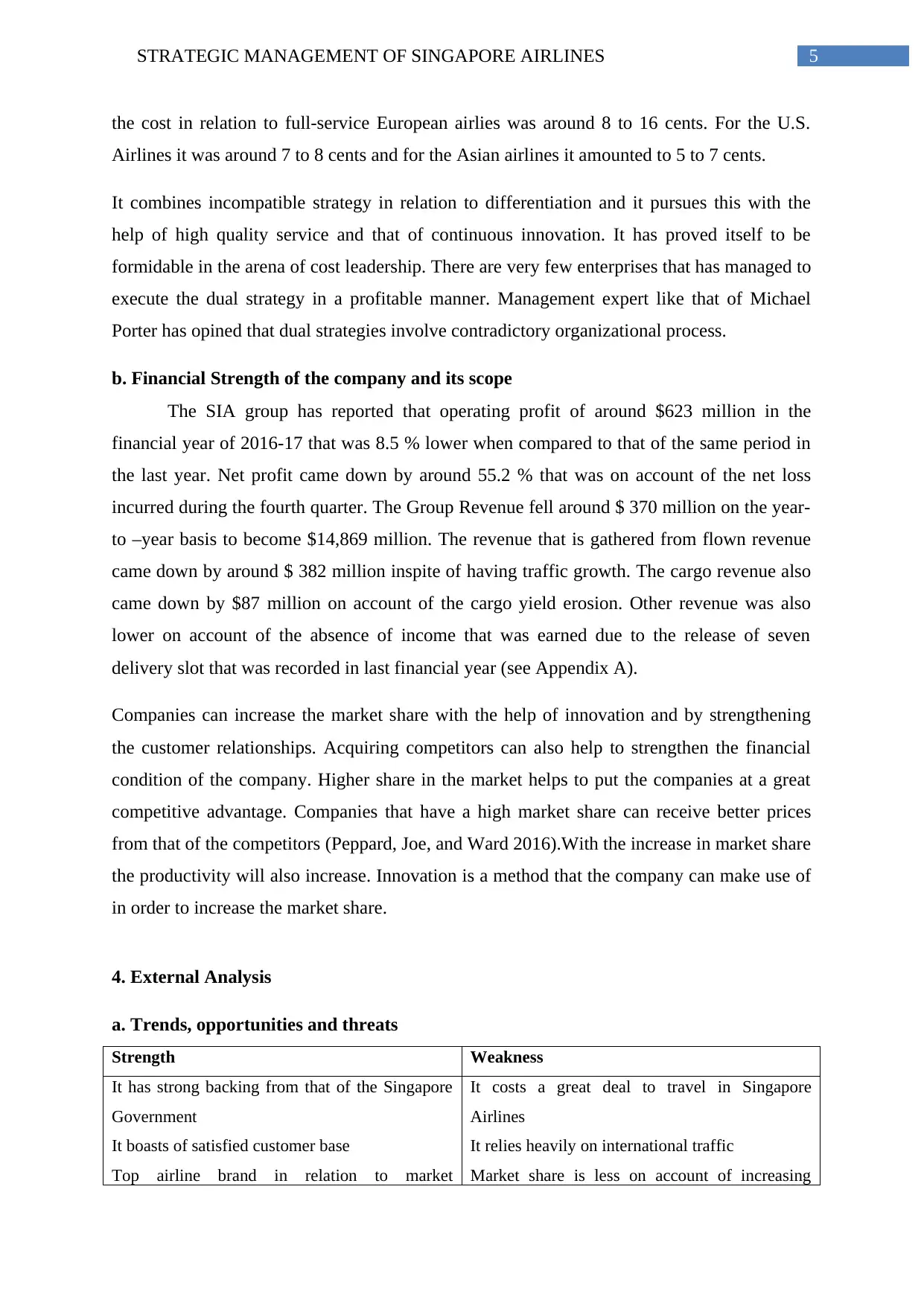
5STRATEGIC MANAGEMENT OF SINGAPORE AIRLINES
the cost in relation to full-service European airlies was around 8 to 16 cents. For the U.S.
Airlines it was around 7 to 8 cents and for the Asian airlines it amounted to 5 to 7 cents.
It combines incompatible strategy in relation to differentiation and it pursues this with the
help of high quality service and that of continuous innovation. It has proved itself to be
formidable in the arena of cost leadership. There are very few enterprises that has managed to
execute the dual strategy in a profitable manner. Management expert like that of Michael
Porter has opined that dual strategies involve contradictory organizational process.
b. Financial Strength of the company and its scope
The SIA group has reported that operating profit of around $623 million in the
financial year of 2016-17 that was 8.5 % lower when compared to that of the same period in
the last year. Net profit came down by around 55.2 % that was on account of the net loss
incurred during the fourth quarter. The Group Revenue fell around $ 370 million on the year-
to –year basis to become $14,869 million. The revenue that is gathered from flown revenue
came down by around $ 382 million inspite of having traffic growth. The cargo revenue also
came down by $87 million on account of the cargo yield erosion. Other revenue was also
lower on account of the absence of income that was earned due to the release of seven
delivery slot that was recorded in last financial year (see Appendix A).
Companies can increase the market share with the help of innovation and by strengthening
the customer relationships. Acquiring competitors can also help to strengthen the financial
condition of the company. Higher share in the market helps to put the companies at a great
competitive advantage. Companies that have a high market share can receive better prices
from that of the competitors (Peppard, Joe, and Ward 2016).With the increase in market share
the productivity will also increase. Innovation is a method that the company can make use of
in order to increase the market share.
4. External Analysis
a. Trends, opportunities and threats
Strength Weakness
It has strong backing from that of the Singapore
Government
It boasts of satisfied customer base
Top airline brand in relation to market
It costs a great deal to travel in Singapore
Airlines
It relies heavily on international traffic
Market share is less on account of increasing
the cost in relation to full-service European airlies was around 8 to 16 cents. For the U.S.
Airlines it was around 7 to 8 cents and for the Asian airlines it amounted to 5 to 7 cents.
It combines incompatible strategy in relation to differentiation and it pursues this with the
help of high quality service and that of continuous innovation. It has proved itself to be
formidable in the arena of cost leadership. There are very few enterprises that has managed to
execute the dual strategy in a profitable manner. Management expert like that of Michael
Porter has opined that dual strategies involve contradictory organizational process.
b. Financial Strength of the company and its scope
The SIA group has reported that operating profit of around $623 million in the
financial year of 2016-17 that was 8.5 % lower when compared to that of the same period in
the last year. Net profit came down by around 55.2 % that was on account of the net loss
incurred during the fourth quarter. The Group Revenue fell around $ 370 million on the year-
to –year basis to become $14,869 million. The revenue that is gathered from flown revenue
came down by around $ 382 million inspite of having traffic growth. The cargo revenue also
came down by $87 million on account of the cargo yield erosion. Other revenue was also
lower on account of the absence of income that was earned due to the release of seven
delivery slot that was recorded in last financial year (see Appendix A).
Companies can increase the market share with the help of innovation and by strengthening
the customer relationships. Acquiring competitors can also help to strengthen the financial
condition of the company. Higher share in the market helps to put the companies at a great
competitive advantage. Companies that have a high market share can receive better prices
from that of the competitors (Peppard, Joe, and Ward 2016).With the increase in market share
the productivity will also increase. Innovation is a method that the company can make use of
in order to increase the market share.
4. External Analysis
a. Trends, opportunities and threats
Strength Weakness
It has strong backing from that of the Singapore
Government
It boasts of satisfied customer base
Top airline brand in relation to market
It costs a great deal to travel in Singapore
Airlines
It relies heavily on international traffic
Market share is less on account of increasing
⊘ This is a preview!⊘
Do you want full access?
Subscribe today to unlock all pages.

Trusted by 1+ million students worldwide
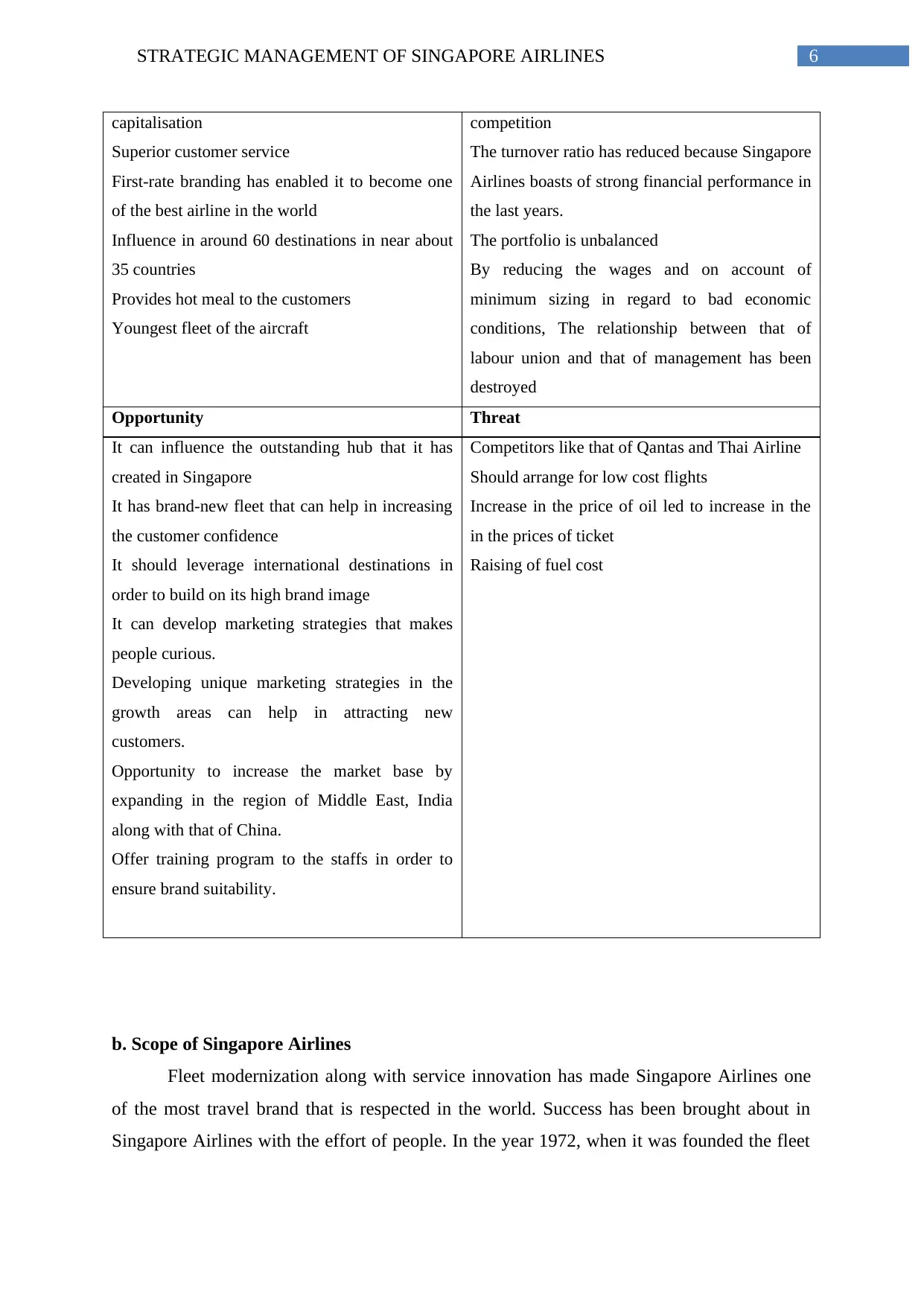
6STRATEGIC MANAGEMENT OF SINGAPORE AIRLINES
capitalisation
Superior customer service
First-rate branding has enabled it to become one
of the best airline in the world
Influence in around 60 destinations in near about
35 countries
Provides hot meal to the customers
Youngest fleet of the aircraft
competition
The turnover ratio has reduced because Singapore
Airlines boasts of strong financial performance in
the last years.
The portfolio is unbalanced
By reducing the wages and on account of
minimum sizing in regard to bad economic
conditions, The relationship between that of
labour union and that of management has been
destroyed
Opportunity Threat
It can influence the outstanding hub that it has
created in Singapore
It has brand-new fleet that can help in increasing
the customer confidence
It should leverage international destinations in
order to build on its high brand image
It can develop marketing strategies that makes
people curious.
Developing unique marketing strategies in the
growth areas can help in attracting new
customers.
Opportunity to increase the market base by
expanding in the region of Middle East, India
along with that of China.
Offer training program to the staffs in order to
ensure brand suitability.
Competitors like that of Qantas and Thai Airline
Should arrange for low cost flights
Increase in the price of oil led to increase in the
in the prices of ticket
Raising of fuel cost
b. Scope of Singapore Airlines
Fleet modernization along with service innovation has made Singapore Airlines one
of the most travel brand that is respected in the world. Success has been brought about in
Singapore Airlines with the effort of people. In the year 1972, when it was founded the fleet
capitalisation
Superior customer service
First-rate branding has enabled it to become one
of the best airline in the world
Influence in around 60 destinations in near about
35 countries
Provides hot meal to the customers
Youngest fleet of the aircraft
competition
The turnover ratio has reduced because Singapore
Airlines boasts of strong financial performance in
the last years.
The portfolio is unbalanced
By reducing the wages and on account of
minimum sizing in regard to bad economic
conditions, The relationship between that of
labour union and that of management has been
destroyed
Opportunity Threat
It can influence the outstanding hub that it has
created in Singapore
It has brand-new fleet that can help in increasing
the customer confidence
It should leverage international destinations in
order to build on its high brand image
It can develop marketing strategies that makes
people curious.
Developing unique marketing strategies in the
growth areas can help in attracting new
customers.
Opportunity to increase the market base by
expanding in the region of Middle East, India
along with that of China.
Offer training program to the staffs in order to
ensure brand suitability.
Competitors like that of Qantas and Thai Airline
Should arrange for low cost flights
Increase in the price of oil led to increase in the
in the prices of ticket
Raising of fuel cost
b. Scope of Singapore Airlines
Fleet modernization along with service innovation has made Singapore Airlines one
of the most travel brand that is respected in the world. Success has been brought about in
Singapore Airlines with the effort of people. In the year 1972, when it was founded the fleet
Paraphrase This Document
Need a fresh take? Get an instant paraphrase of this document with our AI Paraphraser
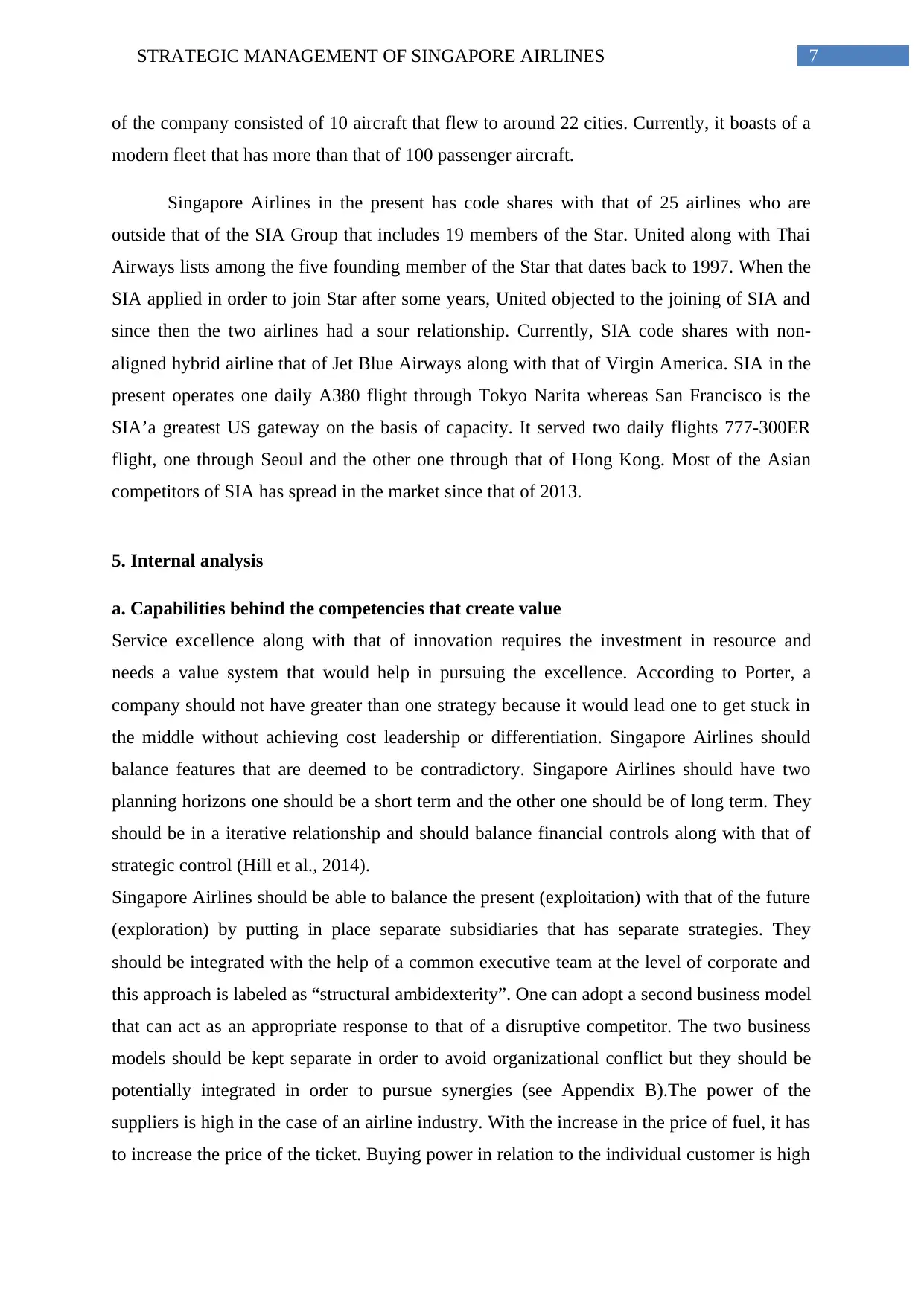
7STRATEGIC MANAGEMENT OF SINGAPORE AIRLINES
of the company consisted of 10 aircraft that flew to around 22 cities. Currently, it boasts of a
modern fleet that has more than that of 100 passenger aircraft.
Singapore Airlines in the present has code shares with that of 25 airlines who are
outside that of the SIA Group that includes 19 members of the Star. United along with Thai
Airways lists among the five founding member of the Star that dates back to 1997. When the
SIA applied in order to join Star after some years, United objected to the joining of SIA and
since then the two airlines had a sour relationship. Currently, SIA code shares with non-
aligned hybrid airline that of Jet Blue Airways along with that of Virgin America. SIA in the
present operates one daily A380 flight through Tokyo Narita whereas San Francisco is the
SIA’a greatest US gateway on the basis of capacity. It served two daily flights 777-300ER
flight, one through Seoul and the other one through that of Hong Kong. Most of the Asian
competitors of SIA has spread in the market since that of 2013.
5. Internal analysis
a. Capabilities behind the competencies that create value
Service excellence along with that of innovation requires the investment in resource and
needs a value system that would help in pursuing the excellence. According to Porter, a
company should not have greater than one strategy because it would lead one to get stuck in
the middle without achieving cost leadership or differentiation. Singapore Airlines should
balance features that are deemed to be contradictory. Singapore Airlines should have two
planning horizons one should be a short term and the other one should be of long term. They
should be in a iterative relationship and should balance financial controls along with that of
strategic control (Hill et al., 2014).
Singapore Airlines should be able to balance the present (exploitation) with that of the future
(exploration) by putting in place separate subsidiaries that has separate strategies. They
should be integrated with the help of a common executive team at the level of corporate and
this approach is labeled as “structural ambidexterity”. One can adopt a second business model
that can act as an appropriate response to that of a disruptive competitor. The two business
models should be kept separate in order to avoid organizational conflict but they should be
potentially integrated in order to pursue synergies (see Appendix B).The power of the
suppliers is high in the case of an airline industry. With the increase in the price of fuel, it has
to increase the price of the ticket. Buying power in relation to the individual customer is high
of the company consisted of 10 aircraft that flew to around 22 cities. Currently, it boasts of a
modern fleet that has more than that of 100 passenger aircraft.
Singapore Airlines in the present has code shares with that of 25 airlines who are
outside that of the SIA Group that includes 19 members of the Star. United along with Thai
Airways lists among the five founding member of the Star that dates back to 1997. When the
SIA applied in order to join Star after some years, United objected to the joining of SIA and
since then the two airlines had a sour relationship. Currently, SIA code shares with non-
aligned hybrid airline that of Jet Blue Airways along with that of Virgin America. SIA in the
present operates one daily A380 flight through Tokyo Narita whereas San Francisco is the
SIA’a greatest US gateway on the basis of capacity. It served two daily flights 777-300ER
flight, one through Seoul and the other one through that of Hong Kong. Most of the Asian
competitors of SIA has spread in the market since that of 2013.
5. Internal analysis
a. Capabilities behind the competencies that create value
Service excellence along with that of innovation requires the investment in resource and
needs a value system that would help in pursuing the excellence. According to Porter, a
company should not have greater than one strategy because it would lead one to get stuck in
the middle without achieving cost leadership or differentiation. Singapore Airlines should
balance features that are deemed to be contradictory. Singapore Airlines should have two
planning horizons one should be a short term and the other one should be of long term. They
should be in a iterative relationship and should balance financial controls along with that of
strategic control (Hill et al., 2014).
Singapore Airlines should be able to balance the present (exploitation) with that of the future
(exploration) by putting in place separate subsidiaries that has separate strategies. They
should be integrated with the help of a common executive team at the level of corporate and
this approach is labeled as “structural ambidexterity”. One can adopt a second business model
that can act as an appropriate response to that of a disruptive competitor. The two business
models should be kept separate in order to avoid organizational conflict but they should be
potentially integrated in order to pursue synergies (see Appendix B).The power of the
suppliers is high in the case of an airline industry. With the increase in the price of fuel, it has
to increase the price of the ticket. Buying power in relation to the individual customer is high
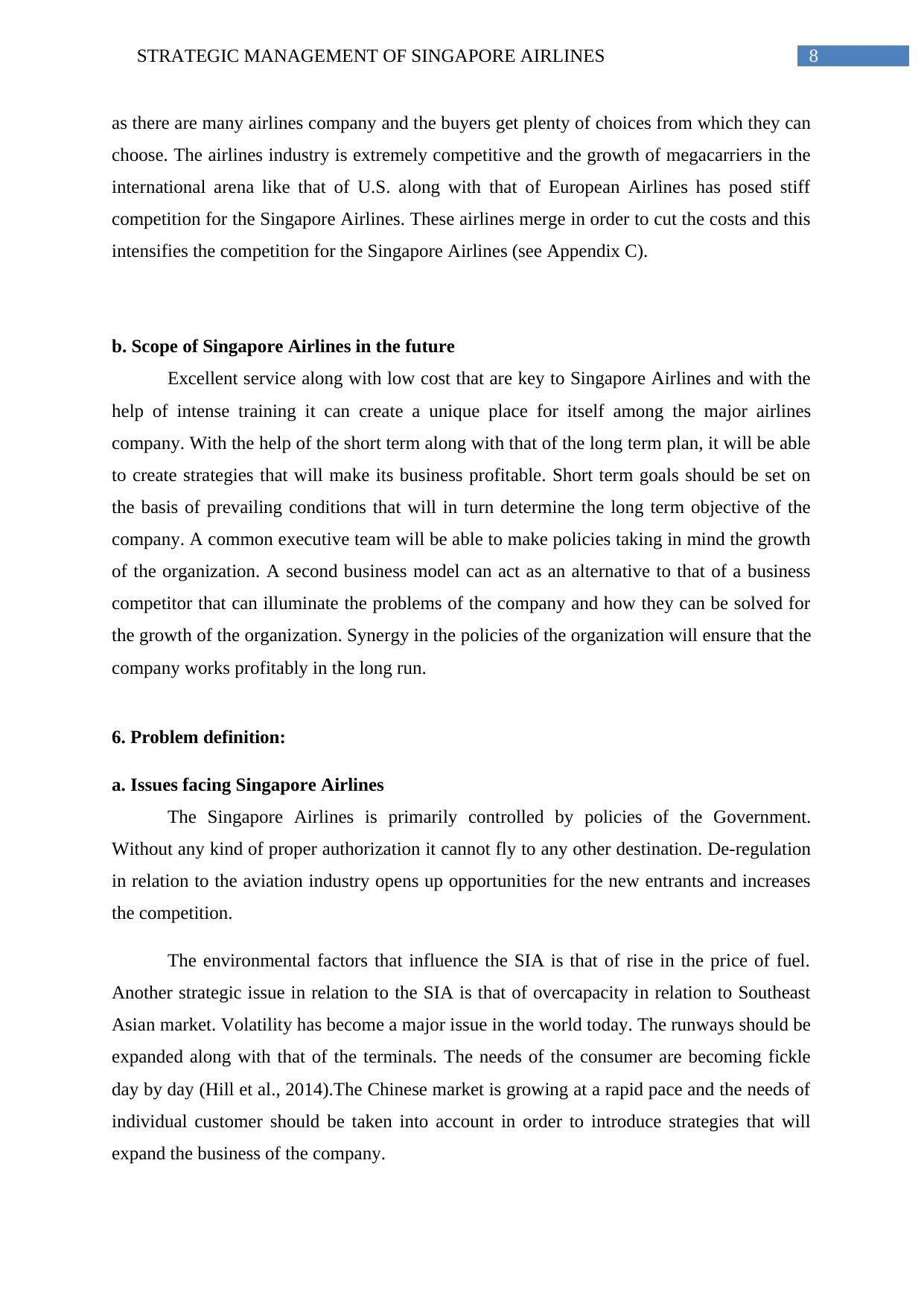
8STRATEGIC MANAGEMENT OF SINGAPORE AIRLINES
as there are many airlines company and the buyers get plenty of choices from which they can
choose. The airlines industry is extremely competitive and the growth of megacarriers in the
international arena like that of U.S. along with that of European Airlines has posed stiff
competition for the Singapore Airlines. These airlines merge in order to cut the costs and this
intensifies the competition for the Singapore Airlines (see Appendix C).
b. Scope of Singapore Airlines in the future
Excellent service along with low cost that are key to Singapore Airlines and with the
help of intense training it can create a unique place for itself among the major airlines
company. With the help of the short term along with that of the long term plan, it will be able
to create strategies that will make its business profitable. Short term goals should be set on
the basis of prevailing conditions that will in turn determine the long term objective of the
company. A common executive team will be able to make policies taking in mind the growth
of the organization. A second business model can act as an alternative to that of a business
competitor that can illuminate the problems of the company and how they can be solved for
the growth of the organization. Synergy in the policies of the organization will ensure that the
company works profitably in the long run.
6. Problem definition:
a. Issues facing Singapore Airlines
The Singapore Airlines is primarily controlled by policies of the Government.
Without any kind of proper authorization it cannot fly to any other destination. De-regulation
in relation to the aviation industry opens up opportunities for the new entrants and increases
the competition.
The environmental factors that influence the SIA is that of rise in the price of fuel.
Another strategic issue in relation to the SIA is that of overcapacity in relation to Southeast
Asian market. Volatility has become a major issue in the world today. The runways should be
expanded along with that of the terminals. The needs of the consumer are becoming fickle
day by day (Hill et al., 2014).The Chinese market is growing at a rapid pace and the needs of
individual customer should be taken into account in order to introduce strategies that will
expand the business of the company.
as there are many airlines company and the buyers get plenty of choices from which they can
choose. The airlines industry is extremely competitive and the growth of megacarriers in the
international arena like that of U.S. along with that of European Airlines has posed stiff
competition for the Singapore Airlines. These airlines merge in order to cut the costs and this
intensifies the competition for the Singapore Airlines (see Appendix C).
b. Scope of Singapore Airlines in the future
Excellent service along with low cost that are key to Singapore Airlines and with the
help of intense training it can create a unique place for itself among the major airlines
company. With the help of the short term along with that of the long term plan, it will be able
to create strategies that will make its business profitable. Short term goals should be set on
the basis of prevailing conditions that will in turn determine the long term objective of the
company. A common executive team will be able to make policies taking in mind the growth
of the organization. A second business model can act as an alternative to that of a business
competitor that can illuminate the problems of the company and how they can be solved for
the growth of the organization. Synergy in the policies of the organization will ensure that the
company works profitably in the long run.
6. Problem definition:
a. Issues facing Singapore Airlines
The Singapore Airlines is primarily controlled by policies of the Government.
Without any kind of proper authorization it cannot fly to any other destination. De-regulation
in relation to the aviation industry opens up opportunities for the new entrants and increases
the competition.
The environmental factors that influence the SIA is that of rise in the price of fuel.
Another strategic issue in relation to the SIA is that of overcapacity in relation to Southeast
Asian market. Volatility has become a major issue in the world today. The runways should be
expanded along with that of the terminals. The needs of the consumer are becoming fickle
day by day (Hill et al., 2014).The Chinese market is growing at a rapid pace and the needs of
individual customer should be taken into account in order to introduce strategies that will
expand the business of the company.
⊘ This is a preview!⊘
Do you want full access?
Subscribe today to unlock all pages.

Trusted by 1+ million students worldwide
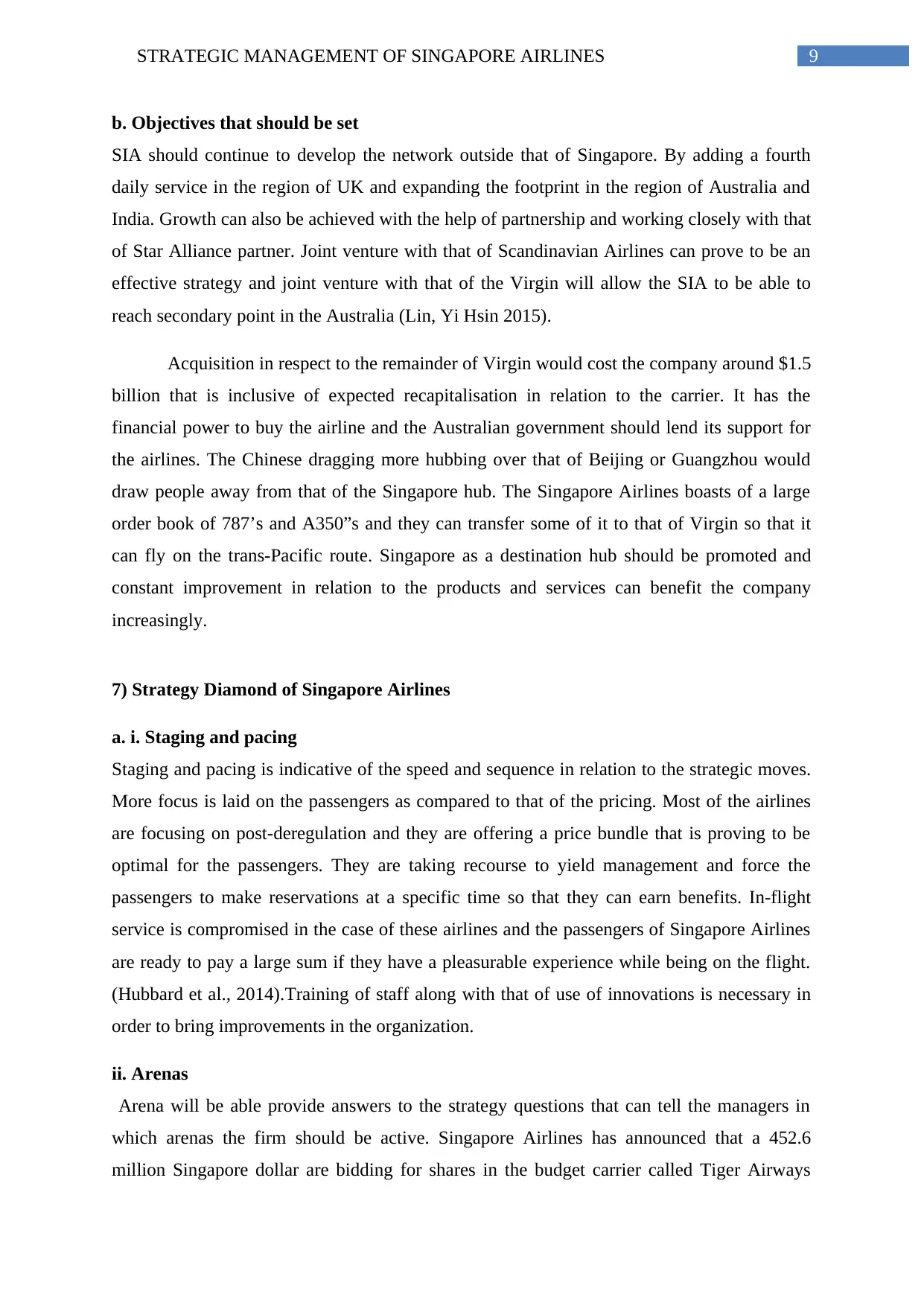
9STRATEGIC MANAGEMENT OF SINGAPORE AIRLINES
b. Objectives that should be set
SIA should continue to develop the network outside that of Singapore. By adding a fourth
daily service in the region of UK and expanding the footprint in the region of Australia and
India. Growth can also be achieved with the help of partnership and working closely with that
of Star Alliance partner. Joint venture with that of Scandinavian Airlines can prove to be an
effective strategy and joint venture with that of the Virgin will allow the SIA to be able to
reach secondary point in the Australia (Lin, Yi Hsin 2015).
Acquisition in respect to the remainder of Virgin would cost the company around $1.5
billion that is inclusive of expected recapitalisation in relation to the carrier. It has the
financial power to buy the airline and the Australian government should lend its support for
the airlines. The Chinese dragging more hubbing over that of Beijing or Guangzhou would
draw people away from that of the Singapore hub. The Singapore Airlines boasts of a large
order book of 787’s and A350”s and they can transfer some of it to that of Virgin so that it
can fly on the trans-Pacific route. Singapore as a destination hub should be promoted and
constant improvement in relation to the products and services can benefit the company
increasingly.
7) Strategy Diamond of Singapore Airlines
a. i. Staging and pacing
Staging and pacing is indicative of the speed and sequence in relation to the strategic moves.
More focus is laid on the passengers as compared to that of the pricing. Most of the airlines
are focusing on post-deregulation and they are offering a price bundle that is proving to be
optimal for the passengers. They are taking recourse to yield management and force the
passengers to make reservations at a specific time so that they can earn benefits. In-flight
service is compromised in the case of these airlines and the passengers of Singapore Airlines
are ready to pay a large sum if they have a pleasurable experience while being on the flight.
(Hubbard et al., 2014).Training of staff along with that of use of innovations is necessary in
order to bring improvements in the organization.
ii. Arenas
Arena will be able provide answers to the strategy questions that can tell the managers in
which arenas the firm should be active. Singapore Airlines has announced that a 452.6
million Singapore dollar are bidding for shares in the budget carrier called Tiger Airways
b. Objectives that should be set
SIA should continue to develop the network outside that of Singapore. By adding a fourth
daily service in the region of UK and expanding the footprint in the region of Australia and
India. Growth can also be achieved with the help of partnership and working closely with that
of Star Alliance partner. Joint venture with that of Scandinavian Airlines can prove to be an
effective strategy and joint venture with that of the Virgin will allow the SIA to be able to
reach secondary point in the Australia (Lin, Yi Hsin 2015).
Acquisition in respect to the remainder of Virgin would cost the company around $1.5
billion that is inclusive of expected recapitalisation in relation to the carrier. It has the
financial power to buy the airline and the Australian government should lend its support for
the airlines. The Chinese dragging more hubbing over that of Beijing or Guangzhou would
draw people away from that of the Singapore hub. The Singapore Airlines boasts of a large
order book of 787’s and A350”s and they can transfer some of it to that of Virgin so that it
can fly on the trans-Pacific route. Singapore as a destination hub should be promoted and
constant improvement in relation to the products and services can benefit the company
increasingly.
7) Strategy Diamond of Singapore Airlines
a. i. Staging and pacing
Staging and pacing is indicative of the speed and sequence in relation to the strategic moves.
More focus is laid on the passengers as compared to that of the pricing. Most of the airlines
are focusing on post-deregulation and they are offering a price bundle that is proving to be
optimal for the passengers. They are taking recourse to yield management and force the
passengers to make reservations at a specific time so that they can earn benefits. In-flight
service is compromised in the case of these airlines and the passengers of Singapore Airlines
are ready to pay a large sum if they have a pleasurable experience while being on the flight.
(Hubbard et al., 2014).Training of staff along with that of use of innovations is necessary in
order to bring improvements in the organization.
ii. Arenas
Arena will be able provide answers to the strategy questions that can tell the managers in
which arenas the firm should be active. Singapore Airlines has announced that a 452.6
million Singapore dollar are bidding for shares in the budget carrier called Tiger Airways
Paraphrase This Document
Need a fresh take? Get an instant paraphrase of this document with our AI Paraphraser
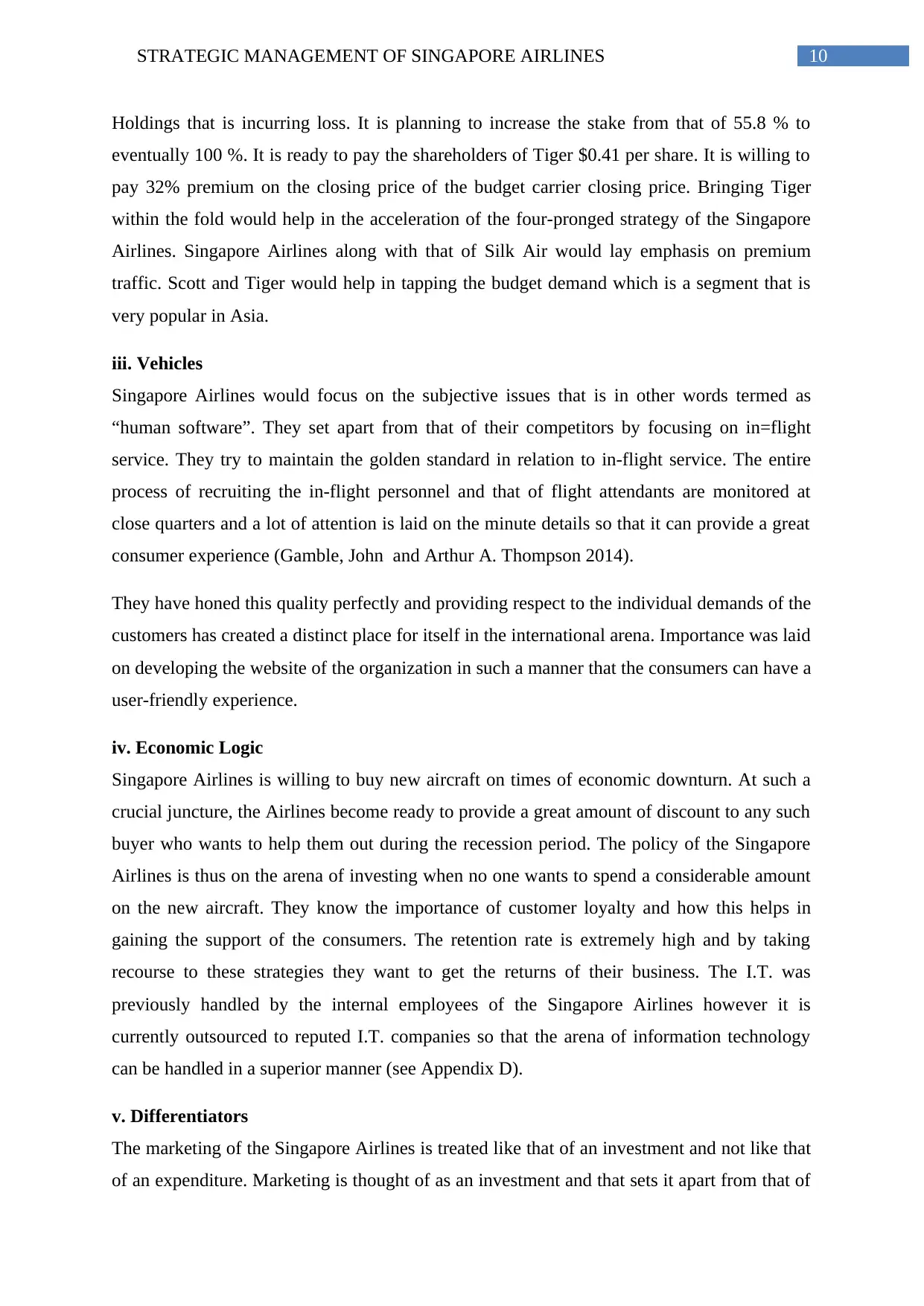
10STRATEGIC MANAGEMENT OF SINGAPORE AIRLINES
Holdings that is incurring loss. It is planning to increase the stake from that of 55.8 % to
eventually 100 %. It is ready to pay the shareholders of Tiger $0.41 per share. It is willing to
pay 32% premium on the closing price of the budget carrier closing price. Bringing Tiger
within the fold would help in the acceleration of the four-pronged strategy of the Singapore
Airlines. Singapore Airlines along with that of Silk Air would lay emphasis on premium
traffic. Scott and Tiger would help in tapping the budget demand which is a segment that is
very popular in Asia.
iii. Vehicles
Singapore Airlines would focus on the subjective issues that is in other words termed as
“human software”. They set apart from that of their competitors by focusing on in=flight
service. They try to maintain the golden standard in relation to in-flight service. The entire
process of recruiting the in-flight personnel and that of flight attendants are monitored at
close quarters and a lot of attention is laid on the minute details so that it can provide a great
consumer experience (Gamble, John and Arthur A. Thompson 2014).
They have honed this quality perfectly and providing respect to the individual demands of the
customers has created a distinct place for itself in the international arena. Importance was laid
on developing the website of the organization in such a manner that the consumers can have a
user-friendly experience.
iv. Economic Logic
Singapore Airlines is willing to buy new aircraft on times of economic downturn. At such a
crucial juncture, the Airlines become ready to provide a great amount of discount to any such
buyer who wants to help them out during the recession period. The policy of the Singapore
Airlines is thus on the arena of investing when no one wants to spend a considerable amount
on the new aircraft. They know the importance of customer loyalty and how this helps in
gaining the support of the consumers. The retention rate is extremely high and by taking
recourse to these strategies they want to get the returns of their business. The I.T. was
previously handled by the internal employees of the Singapore Airlines however it is
currently outsourced to reputed I.T. companies so that the arena of information technology
can be handled in a superior manner (see Appendix D).
v. Differentiators
The marketing of the Singapore Airlines is treated like that of an investment and not like that
of an expenditure. Marketing is thought of as an investment and that sets it apart from that of
Holdings that is incurring loss. It is planning to increase the stake from that of 55.8 % to
eventually 100 %. It is ready to pay the shareholders of Tiger $0.41 per share. It is willing to
pay 32% premium on the closing price of the budget carrier closing price. Bringing Tiger
within the fold would help in the acceleration of the four-pronged strategy of the Singapore
Airlines. Singapore Airlines along with that of Silk Air would lay emphasis on premium
traffic. Scott and Tiger would help in tapping the budget demand which is a segment that is
very popular in Asia.
iii. Vehicles
Singapore Airlines would focus on the subjective issues that is in other words termed as
“human software”. They set apart from that of their competitors by focusing on in=flight
service. They try to maintain the golden standard in relation to in-flight service. The entire
process of recruiting the in-flight personnel and that of flight attendants are monitored at
close quarters and a lot of attention is laid on the minute details so that it can provide a great
consumer experience (Gamble, John and Arthur A. Thompson 2014).
They have honed this quality perfectly and providing respect to the individual demands of the
customers has created a distinct place for itself in the international arena. Importance was laid
on developing the website of the organization in such a manner that the consumers can have a
user-friendly experience.
iv. Economic Logic
Singapore Airlines is willing to buy new aircraft on times of economic downturn. At such a
crucial juncture, the Airlines become ready to provide a great amount of discount to any such
buyer who wants to help them out during the recession period. The policy of the Singapore
Airlines is thus on the arena of investing when no one wants to spend a considerable amount
on the new aircraft. They know the importance of customer loyalty and how this helps in
gaining the support of the consumers. The retention rate is extremely high and by taking
recourse to these strategies they want to get the returns of their business. The I.T. was
previously handled by the internal employees of the Singapore Airlines however it is
currently outsourced to reputed I.T. companies so that the arena of information technology
can be handled in a superior manner (see Appendix D).
v. Differentiators
The marketing of the Singapore Airlines is treated like that of an investment and not like that
of an expenditure. Marketing is thought of as an investment and that sets it apart from that of
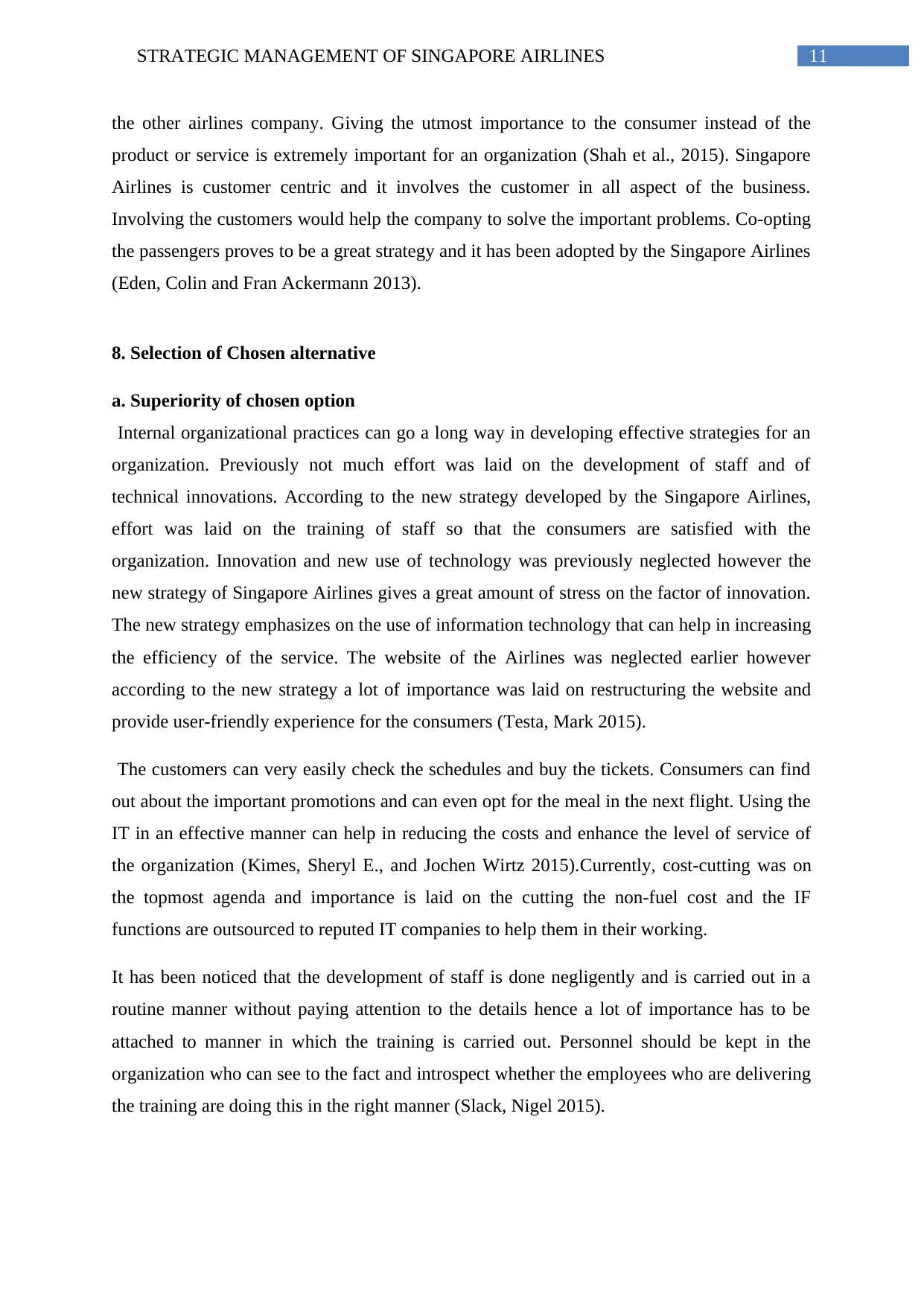
11STRATEGIC MANAGEMENT OF SINGAPORE AIRLINES
the other airlines company. Giving the utmost importance to the consumer instead of the
product or service is extremely important for an organization (Shah et al., 2015). Singapore
Airlines is customer centric and it involves the customer in all aspect of the business.
Involving the customers would help the company to solve the important problems. Co-opting
the passengers proves to be a great strategy and it has been adopted by the Singapore Airlines
(Eden, Colin and Fran Ackermann 2013).
8. Selection of Chosen alternative
a. Superiority of chosen option
Internal organizational practices can go a long way in developing effective strategies for an
organization. Previously not much effort was laid on the development of staff and of
technical innovations. According to the new strategy developed by the Singapore Airlines,
effort was laid on the training of staff so that the consumers are satisfied with the
organization. Innovation and new use of technology was previously neglected however the
new strategy of Singapore Airlines gives a great amount of stress on the factor of innovation.
The new strategy emphasizes on the use of information technology that can help in increasing
the efficiency of the service. The website of the Airlines was neglected earlier however
according to the new strategy a lot of importance was laid on restructuring the website and
provide user-friendly experience for the consumers (Testa, Mark 2015).
The customers can very easily check the schedules and buy the tickets. Consumers can find
out about the important promotions and can even opt for the meal in the next flight. Using the
IT in an effective manner can help in reducing the costs and enhance the level of service of
the organization (Kimes, Sheryl E., and Jochen Wirtz 2015).Currently, cost-cutting was on
the topmost agenda and importance is laid on the cutting the non-fuel cost and the IF
functions are outsourced to reputed IT companies to help them in their working.
It has been noticed that the development of staff is done negligently and is carried out in a
routine manner without paying attention to the details hence a lot of importance has to be
attached to manner in which the training is carried out. Personnel should be kept in the
organization who can see to the fact and introspect whether the employees who are delivering
the training are doing this in the right manner (Slack, Nigel 2015).
the other airlines company. Giving the utmost importance to the consumer instead of the
product or service is extremely important for an organization (Shah et al., 2015). Singapore
Airlines is customer centric and it involves the customer in all aspect of the business.
Involving the customers would help the company to solve the important problems. Co-opting
the passengers proves to be a great strategy and it has been adopted by the Singapore Airlines
(Eden, Colin and Fran Ackermann 2013).
8. Selection of Chosen alternative
a. Superiority of chosen option
Internal organizational practices can go a long way in developing effective strategies for an
organization. Previously not much effort was laid on the development of staff and of
technical innovations. According to the new strategy developed by the Singapore Airlines,
effort was laid on the training of staff so that the consumers are satisfied with the
organization. Innovation and new use of technology was previously neglected however the
new strategy of Singapore Airlines gives a great amount of stress on the factor of innovation.
The new strategy emphasizes on the use of information technology that can help in increasing
the efficiency of the service. The website of the Airlines was neglected earlier however
according to the new strategy a lot of importance was laid on restructuring the website and
provide user-friendly experience for the consumers (Testa, Mark 2015).
The customers can very easily check the schedules and buy the tickets. Consumers can find
out about the important promotions and can even opt for the meal in the next flight. Using the
IT in an effective manner can help in reducing the costs and enhance the level of service of
the organization (Kimes, Sheryl E., and Jochen Wirtz 2015).Currently, cost-cutting was on
the topmost agenda and importance is laid on the cutting the non-fuel cost and the IF
functions are outsourced to reputed IT companies to help them in their working.
It has been noticed that the development of staff is done negligently and is carried out in a
routine manner without paying attention to the details hence a lot of importance has to be
attached to manner in which the training is carried out. Personnel should be kept in the
organization who can see to the fact and introspect whether the employees who are delivering
the training are doing this in the right manner (Slack, Nigel 2015).
⊘ This is a preview!⊘
Do you want full access?
Subscribe today to unlock all pages.

Trusted by 1+ million students worldwide
1 out of 23
Related Documents
Your All-in-One AI-Powered Toolkit for Academic Success.
+13062052269
info@desklib.com
Available 24*7 on WhatsApp / Email
![[object Object]](/_next/static/media/star-bottom.7253800d.svg)
Unlock your academic potential
Copyright © 2020–2025 A2Z Services. All Rights Reserved. Developed and managed by ZUCOL.





